We find cemeteries to be fascinating places to visit – they give an insight into a country’s religion and cultures as well as often containing sculpture and interesting architecture. All of which makes them great places to take photos.
In Cuba we found cemeteries to be peaceful, hassle-free places to explore, though be warned if you want to follow in our path, there’s rarely any shade and the heat can be brutal in the middle of the day.
Here’s a selection of my favourite photos from the Cuban cemeteries that we visited.
 The first cemetery that we visited was Santa Ifigenia in Santiago de Cuba, a sea of white marble and palm trees against the blue Caribbean sky
The first cemetery that we visited was Santa Ifigenia in Santiago de Cuba, a sea of white marble and palm trees against the blue Caribbean sky
 Santa Ifigenia cemetery is the resting place of José Martí, Cuba’s national hero (writer, poet, independence fighter)
Santa Ifigenia cemetery is the resting place of José Martí, Cuba’s national hero (writer, poet, independence fighter)
 Inside José Martí’s mausoleum, the casket is draped in a Cuban flag and catches daily shafts of sunlight in response to a line in one of his poems about being buried with his visage facing the sun
Inside José Martí’s mausoleum, the casket is draped in a Cuban flag and catches daily shafts of sunlight in response to a line in one of his poems about being buried with his visage facing the sun
 There is a twice hourly changing of the guard ceremony at José Martí’s tomb. At 8.30am we were the only ones there, by 10.30am the audience lining the path was large.
There is a twice hourly changing of the guard ceremony at José Martí’s tomb. At 8.30am we were the only ones there, by 10.30am the audience lining the path was large.
 All the cemeteries we visited had mausoleums for soldiers killed during the revolutionary fighting, this one honours those who lost their lives during the Moncada Barracks attacks
All the cemeteries we visited had mausoleums for soldiers killed during the revolutionary fighting, this one honours those who lost their lives during the Moncada Barracks attacks
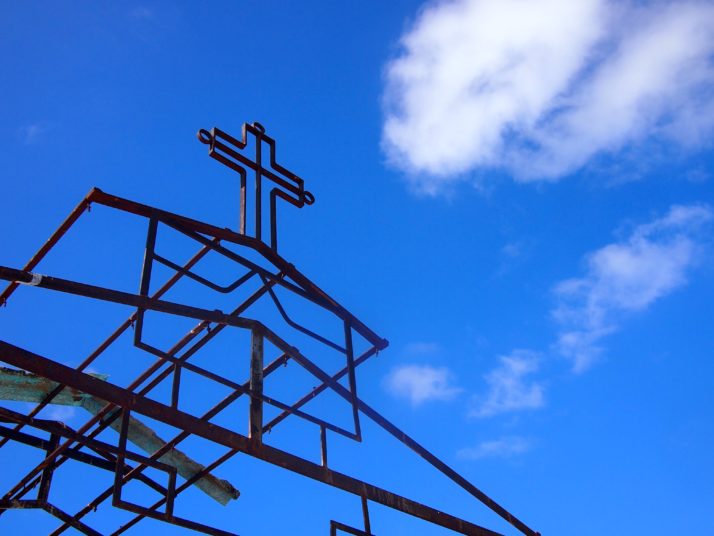 Most of the gravestones at Santa Ifigenia cemetery were white marble but there were a few exceptions like this metal canopy with a cross
Most of the gravestones at Santa Ifigenia cemetery were white marble but there were a few exceptions like this metal canopy with a cross
 Compay Segundo, guitarist and singer in the Buena Vista Social Club is buried in Santiago de Cuba
Compay Segundo, guitarist and singer in the Buena Vista Social Club is buried in Santiago de Cuba
 The cemetery in Baracoa was much less grand than the one in Santiago but it had a beautiful setting overlooking the sea
The cemetery in Baracoa was much less grand than the one in Santiago but it had a beautiful setting overlooking the sea
 Every cemetery we visited had huge blocks containing square niches, presumably for ashes (there was usually a crematorium building hidden in a back corner as well). Some were simply decorated with the deceased’s name either handpainted or scratched into the wet cement while others had professional plaques, flowers or other decorations
Every cemetery we visited had huge blocks containing square niches, presumably for ashes (there was usually a crematorium building hidden in a back corner as well). Some were simply decorated with the deceased’s name either handpainted or scratched into the wet cement while others had professional plaques, flowers or other decorations
 The cemetery in Camagüey was one of my favourites and with barely any other visitors (and no other tourists) we were free to have a good look around. These grand tombs are close to the entrance near the Iglesia de San Cristo de Buen Viaje (Church of St Christopher).
The cemetery in Camagüey was one of my favourites and with barely any other visitors (and no other tourists) we were free to have a good look around. These grand tombs are close to the entrance near the Iglesia de San Cristo de Buen Viaje (Church of St Christopher).
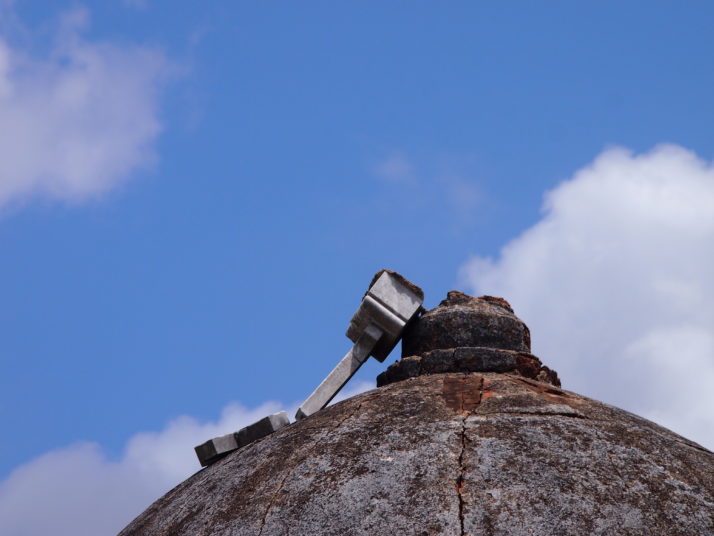 Further into the cemetery more dilapidation was obvious such as this fallen cross
Further into the cemetery more dilapidation was obvious such as this fallen cross
 Plots often seemed to contain whole families with a crowd of plaques on top of the grave, each carrying a different name
Plots often seemed to contain whole families with a crowd of plaques on top of the grave, each carrying a different name
 Columns that look as if they’re about to fall apart in Camagüey
Columns that look as if they’re about to fall apart in Camagüey
 In Santa Clara we didn’t visit the cemetery but the city is home to the most famous mausoleum in the country which contains the remains of Ernesto ‘Che’ Guevara and 16 of the 37 fighters who were killed alongside him in Bolivia. Underneath the statue is a peaceful room of remembrance and an interesting museum documenting Che’s life.
In Santa Clara we didn’t visit the cemetery but the city is home to the most famous mausoleum in the country which contains the remains of Ernesto ‘Che’ Guevara and 16 of the 37 fighters who were killed alongside him in Bolivia. Underneath the statue is a peaceful room of remembrance and an interesting museum documenting Che’s life.
 Fresh flowers are placed below the statue of Che each morning.
Fresh flowers are placed below the statue of Che each morning.
 The Necrópolis Cristóbal Colón (Christopher Columbus cemetery) in Havana is enormous and worthy of this imposing entrance gate
The Necrópolis Cristóbal Colón (Christopher Columbus cemetery) in Havana is enormous and worthy of this imposing entrance gate
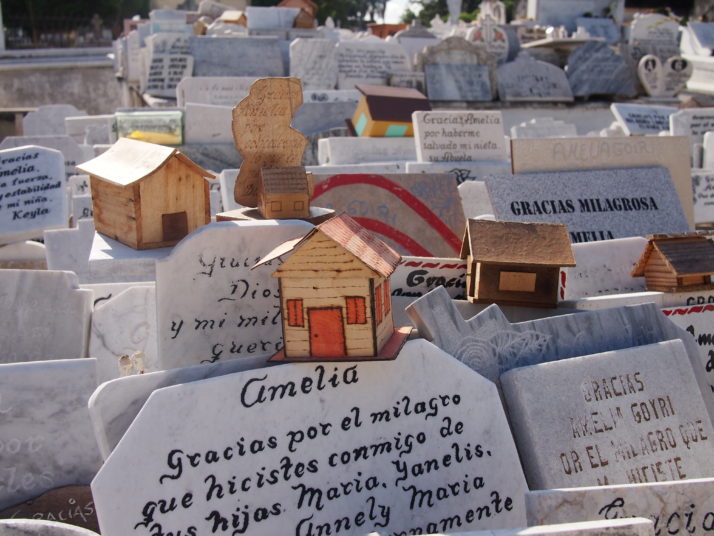 The most famous grave in the cemetery belongs to Amelia Goyri, also known as La Milagrosa or miracle-worker. She died in childbirth in 1901 and was buried with her son. The story goes that when the grave was opened some years late Amelia’s body was uncorrupted and the baby was found not at her feet but in her arms. Since then locals have prayed for her to help with their hopes for children, new houses, etc and now several nearby plots have been overtaken with thank you messages from thoses whose wishes have been fulfilled.
The most famous grave in the cemetery belongs to Amelia Goyri, also known as La Milagrosa or miracle-worker. She died in childbirth in 1901 and was buried with her son. The story goes that when the grave was opened some years late Amelia’s body was uncorrupted and the baby was found not at her feet but in her arms. Since then locals have prayed for her to help with their hopes for children, new houses, etc and now several nearby plots have been overtaken with thank you messages from thoses whose wishes have been fulfilled.
 We enjoyed some of the modern graves in the Necrópolis Cristóbal Colón (clockwise from top left): a modern take on the Pietà by sculptor Rita Longa; according to the internet (!), Juana Martin died while playing dominoes; the glass doors on the pantheon of the Baró family were designed by Lalique; tomb of Nuñes Gálvez
We enjoyed some of the modern graves in the Necrópolis Cristóbal Colón (clockwise from top left): a modern take on the Pietà by sculptor Rita Longa; according to the internet (!), Juana Martin died while playing dominoes; the glass doors on the pantheon of the Baró family were designed by Lalique; tomb of Nuñes Gálvez
 But there is plenty of beautiful white marble as well
But there is plenty of beautiful white marble as well
 There were a number of mausoleums for societies like this one for the Japanese Colony of Cuba. Inside are walls of square niches.
There were a number of mausoleums for societies like this one for the Japanese Colony of Cuba. Inside are walls of square niches.
 The Tobías Gallery is a 100m long underground gallery. We couldn’t enter but from what we could see from the doorway it looks to be piled high with small boxes like these which presumably contain bones or ashes
The Tobías Gallery is a 100m long underground gallery. We couldn’t enter but from what we could see from the doorway it looks to be piled high with small boxes like these which presumably contain bones or ashes
 We visited the cemetery in Trinidad mainly to have a destination away from the tourist-filled city centre. We were rewarded with this tropically apocalyptic view.
We visited the cemetery in Trinidad mainly to have a destination away from the tourist-filled city centre. We were rewarded with this tropically apocalyptic view.
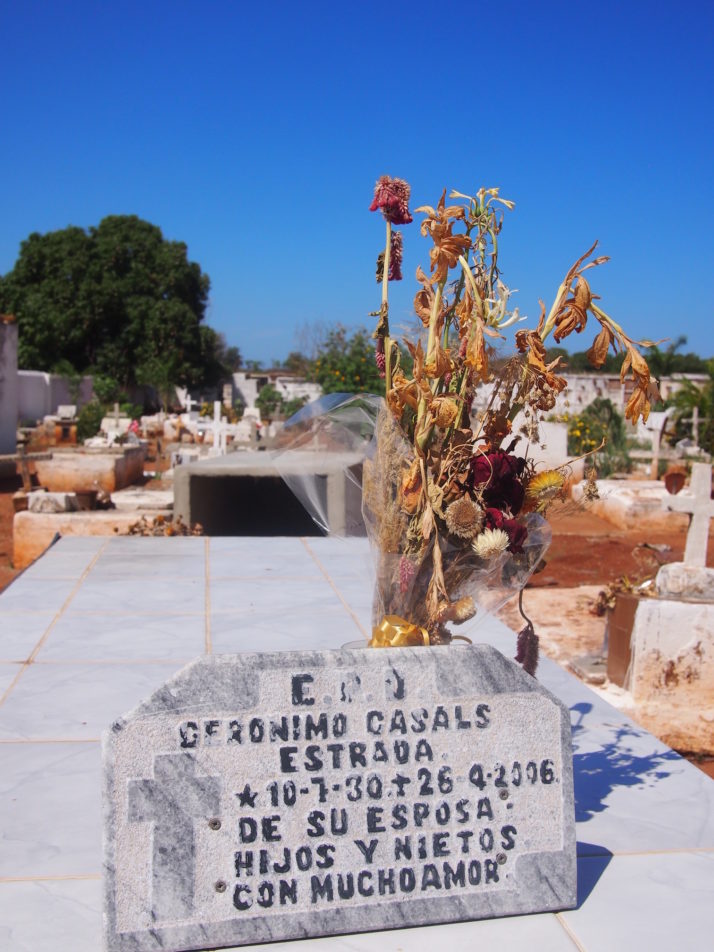 Flowers dry out very quickly in the hot Cuban sun and many graves had fake rather than fresh flowers.
Flowers dry out very quickly in the hot Cuban sun and many graves had fake rather than fresh flowers.
 This grave is topped with a statue of Babaluaye, one of the orishas from Santeria, the religion fused from African animisism and Catholicism. It also holds what I think is the remains of a cigar
This grave is topped with a statue of Babaluaye, one of the orishas from Santeria, the religion fused from African animisism and Catholicism. It also holds what I think is the remains of a cigar
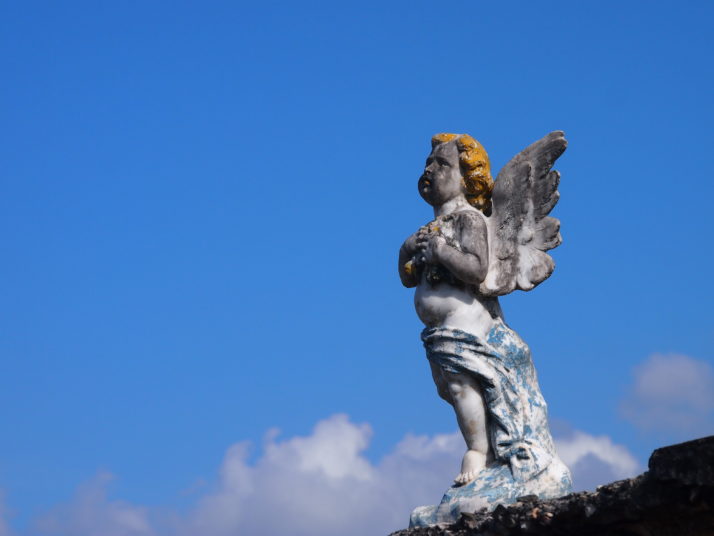 A forlorn and battered cherub tops a tomb in Morón
A forlorn and battered cherub tops a tomb in Morón

 two year trip
two year trip